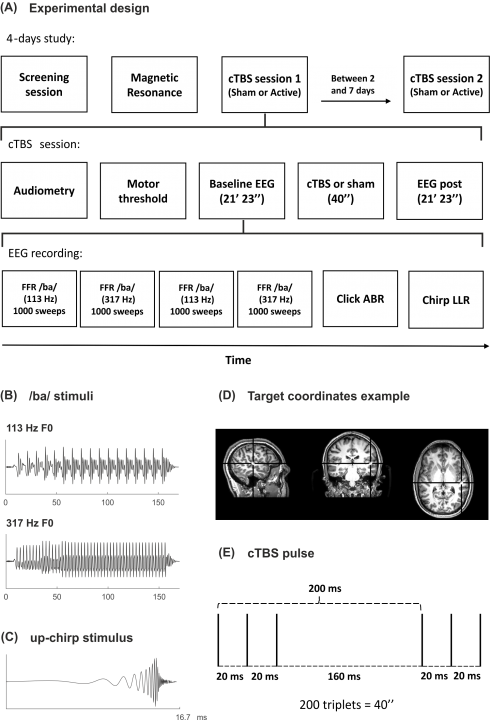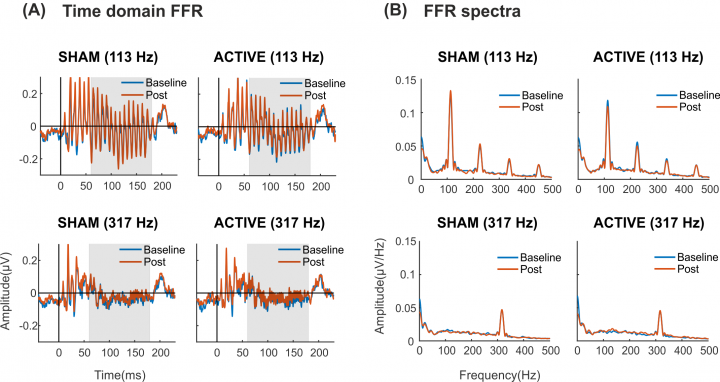The paper entitled Effects of cTBS on the Frequency-Following Response and other auditory evoked potentials, by López-Caballero, Martin-Trias, Ribas-Prats, Gorina-Careta, Bartrés-Faz, and Escera, has been published in the journal Frontiers in Human Neuroscience.
This paper is the outcome of a scientific collaboration between the Brainlab and the Brain Stimulation Lab, lead by Prof. David Bartrés-Faz in our Institute and at the Faculty of Medicine, to investigate the neural generators of the Frequency-Following Response (FFR) through temporal inhibition of the auditory cortex with Theta Burst Stimulation (cTBS). In short, participants’ FFRs were recorded in two sessions, active or sham, after receiving a cTBS or a control sequence in navigated primary auditory cortex. FFRs to the syllable /ba/ uttered at two different F0 (113 Hz and 317 Hz) as well as other auditory evoked potentials (brainstem – ABR, and cortical elicited to chirp and tone) were recorded. Our departing hypothesis was that cTBS would attenuate the low F0 FFR (because its major cortical generators) while leaving unaffected the high-frequency FFR (because its predominantly subcortical sources). However, results were negative, as no effects were observed in fact in any of the recordings during cTBS. Several potential explanations are discussed.

The full abstract reads as follows:
The Frequency-Following Response (FFR) is an auditory evoked potential that follows the periodic characteristics of a sound. Despite being a widely studied biosignal in auditory neuroscience, the neural underpinnings of the FFR are still unclear. Traditionally, FFR was associated with subcortical activity, but recent evidence suggested cortical contributions which may be dependent on the stimulus frequency. We combined EEG with an inhibitory Transcranial Magnetic Stimulation protocol, the continuous Theta Burst Stimulation (cTBS), to disentangle the cortical contribution to the FFR elicited to stimuli of high and low frequency. We recorded FFR to the syllable /ba/ at two fundamental frequencies (Low: 113 Hz; High: 317 Hz) in healthy participants. FFR, cortical potentials and Auditory Brainstem Response (ABR) were recorded before and after real and sham cTBS in the right primary auditory cortex. Results showed that cTBS did not produce a significant change in the FFR recorded, in any of the frequencies. No effect was observed in the ABR and cortical potentials, despite the latter known contributions from auditory cortex. Possible reasons behind the negative results include compensatory mechanisms from the non-targeted areas, intraindividual variability of the cTBS effectiveness and the particular location of our target area, the primary auditory cortex.

Reference:
López-Caballero, F., Martin-Trias, P., Ribas-Prats, T., Gorina-Careta, N., Bartrés-Faz, D., & Escera, C. (2020). Effects of cTBS on the frequency-following response and other auditory evoked potentials. Frontiers in Human Neuroscience, 14:250.
Permanent doi:http://doi.org/10.3389/fnhum.2020.00250.

